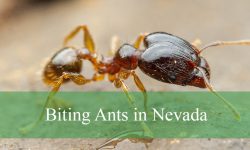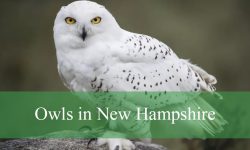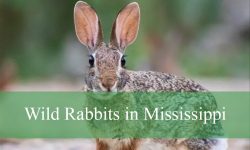Birdwatching in Michigan is full of surprises, and few sights are as rewarding as spotting a flash of orange among the trees. From bold Baltimore Orioles to the fiery Blackburnian Warbler, these colorful birds bring energy and brightness to woodlands, backyards, and orchards across the state.
Each species has its own charm—some sing from the forest canopy, while others visit feeders in suburban gardens. Knowing when and where to look makes all the difference, especially during migration when many orange-plumaged birds pass through Michigan.
This guide will help you identify nine of the most striking orange birds in Michigan. With pictures, details on habitat, and key identification tips, you’ll be ready to recognize them the next time you’re out exploring.
Types of Orange Birds Found in Michigan
Baltimore Oriole (Icterus galbula)
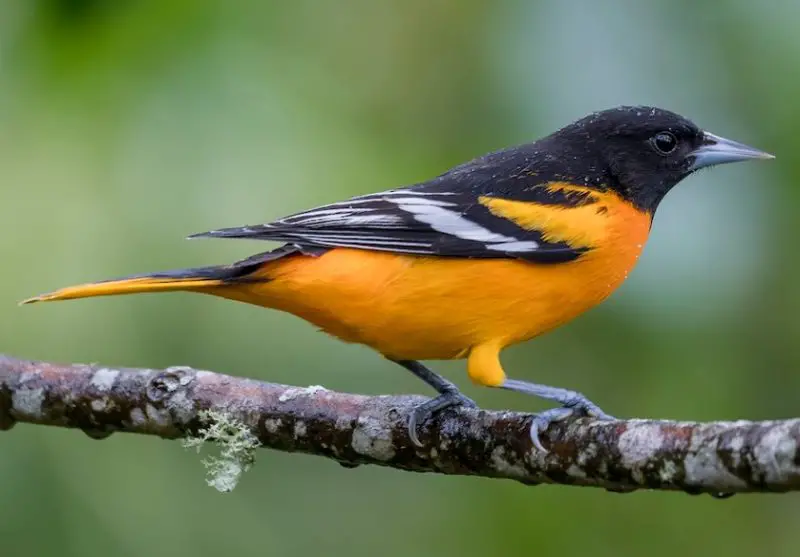
The Baltimore Oriole is one of the most striking orange birds found in Michigan, instantly recognizable for its vivid coloration. Adult males display a fiery orange breast, belly, and rump contrasted with a jet-black head, back, and wings marked by white wing bars. Females are more subdued, with a warm yellow-orange underside and olive-brown wings, but they still retain enough orange tones to make them stand out among songbirds. Their medium size, slender build, and slightly curved bill also help in quick identification when perched or in flight.
These orioles are highly active in the spring and summer, arriving in Michigan around late April to early May after migrating from Central and South America. They prefer open woodlands, edges of forests, orchards, and suburban areas with tall deciduous trees. Homeowners often attract them with offerings of orange halves, grape jelly, or nectar feeders, as these sweet treats mimic their natural diet. Their flutelike, rich whistles echo through treetops, making them one of the most melodious orange-plumed visitors in the state.
In terms of behavior, Baltimore Orioles are agile foragers that move gracefully among branches, probing flowers and leaves for insects, caterpillars, and spiders. Their diet shifts throughout the season, with protein-rich insects favored during nesting and sugary fruits becoming more prominent later in summer. They build remarkable hanging, woven nests suspended from tree branches, crafted from grass, plant fibers, and even bits of string or yarn. These pouch-like nests are engineering marvels and can be spotted dangling from tall trees.
During breeding season, males sing persistently to defend territories and attract mates, while females take the lead in nest building and incubation. Baltimore Orioles are strong migrants, departing Michigan by late August or early September for their wintering grounds. Despite their seasonal presence, they leave a lasting impression thanks to their radiant plumage and sweet, whistled songs.
Orchard Oriole (Icterus spurius)
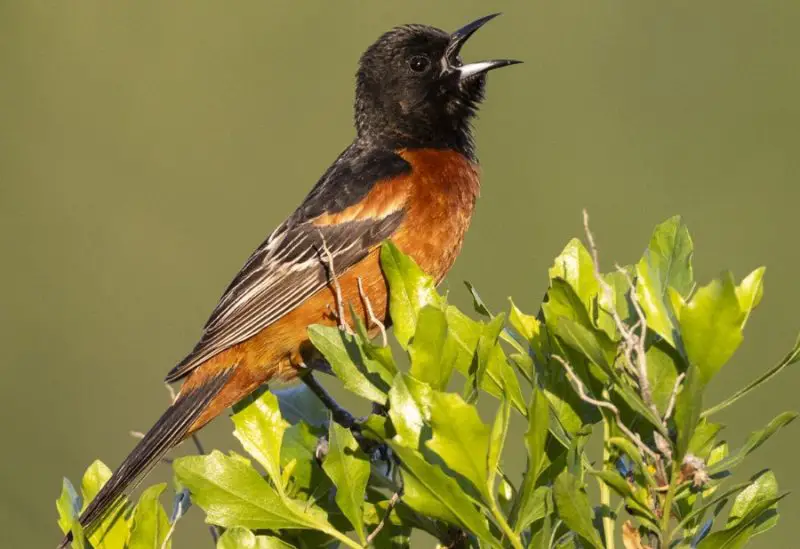
The Orchard Oriole is smaller and less well-known than the Baltimore Oriole, but it also makes its summer home in Michigan. Adult males are distinguished by their deep chestnut-orange underparts and rump, paired with a glossy black head, back, and wings. This darker orange hue gives them a more subtle appearance compared to their Baltimore cousins. Females and immatures, however, are mostly yellow-green with faint orange tones, making identification a bit trickier. Their slim body and slightly decurved bill are classic oriole features that help confirm their identity.
These orioles arrive in Michigan later than most migratory birds, often not appearing until May. They favor orchards, hedgerows, open woodlands, and riparian habitats where scattered trees provide ideal nesting sites. While less common than Baltimore Orioles, they can be found in southern Michigan during the breeding season. Their songs are more rapid and less melodious than the Baltimore Oriole’s, consisting of short whistles and chatters that sometimes resemble a warbler’s song.
Behaviorally, Orchard Orioles feed on a wide range of insects, including beetles, caterpillars, and grasshoppers. They also enjoy nectar and fruit, often sampling mulberries, cherries, and other small berries available in Michigan orchards and natural areas. Like their relatives, they may also be attracted to backyard feeders offering orange slices or nectar. Their foraging tends to be lower in the canopy compared to Baltimore Orioles, often giving observers closer looks.
Nesting habits are equally fascinating, with females weaving hanging nests from grasses, plant fibers, and fine materials. These nests are usually suspended from the ends of branches, offering protection from predators. Orchard Orioles are also among the earliest migrants to leave Michigan, sometimes beginning their southward journey in July. Their presence, though brief, adds a distinctive splash of orange-brown to Michigan’s summer birdscape.
American Robin (Turdus migratorius)
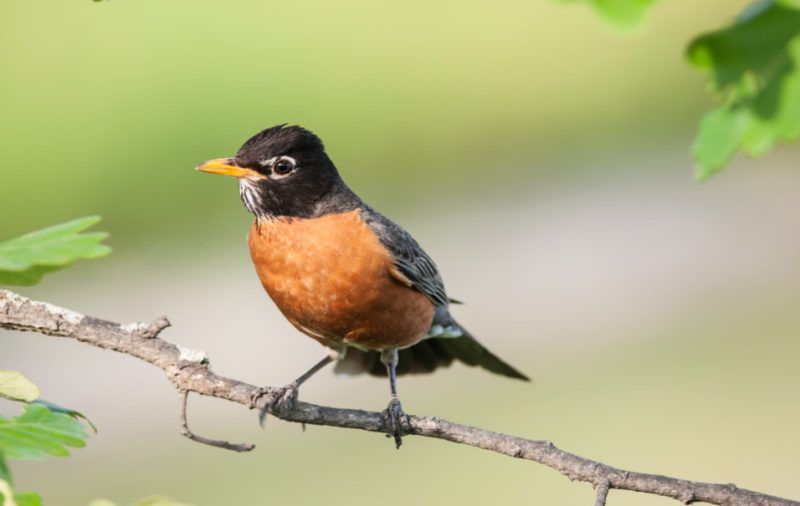
The American Robin is one of Michigan’s most familiar birds, recognized not just for its abundance but also for its distinctive orange breast. Unlike orioles, robins are larger thrushes with a gray-brown back, white eye ring, and a long tail. Their rusty-orange chest and belly stand out vividly against early spring landscapes, often signaling the arrival of warmer weather. Both males and females share similar coloration, although males may appear slightly more vibrant.
American Robins are widespread across Michigan, occupying nearly every habitat from forests and parks to urban neighborhoods and agricultural areas. They are year-round residents in the state, although northern populations may migrate southward in harsh winters. In early spring, robins are among the first birds to sing at dawn, delivering a cheerful series of phrases that many associate with the changing seasons. Their adaptability to both natural and human-altered environments makes them one of the state’s most successful bird species.
In terms of feeding, robins are omnivores that consume a mix of earthworms, insects, and fruits. During spring and summer, they are frequently observed tugging worms from lawns after rain. In autumn and winter, their diet shifts to berries and fruits from shrubs and trees, including crabapples and sumac. This flexible diet ensures their survival even when insect populations dwindle in colder months.
Nesting is another key part of robin behavior, with females constructing sturdy, cup-shaped nests out of grass, mud, and twigs. These nests are often placed on tree branches, ledges, or even man-made structures. Robins are prolific breeders, often raising two or three broods per season. Their orange underparts and widespread presence make them one of Michigan’s most iconic orange-toned birds.
Eastern Towhee (Pipilo erythrophthalmus)
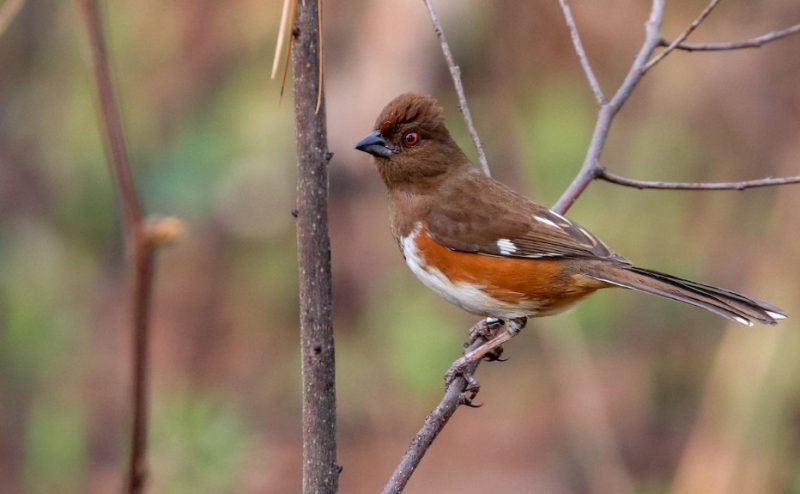
The Eastern Towhee is a striking bird that features a bold mix of orange, black, and white in its plumage. Males are particularly eye-catching with black heads, backs, and wings contrasted by rich orange flanks and a white belly. Females share the same pattern but with brown replacing black, giving them a warmer overall tone. Towhees are sparrow-like in structure but larger, with long tails that they frequently flick while foraging on the ground.
These birds inhabit shrubby edges, thickets, forest borders, and overgrown fields across southern Michigan. They are more often heard than seen, thanks to their habit of staying low in dense cover. Their distinctive “drink-your-tea” song, which rises in pitch, is a common sound in spring and summer. Their sharp “chewink” call is another clue birders use to locate them. Because they often scratch among leaves for food, their rustling activity can betray their presence before they are visible.
Eastern Towhees are primarily ground foragers, feeding on insects, seeds, and berries. They use a characteristic two-footed hopping and scratching motion to uncover food beneath leaf litter. Their diet includes beetles, caterpillars, ants, and grasshoppers, as well as seasonal fruits like blackberries and elderberries. This foraging style makes them an important part of the ecosystem, helping control insect populations and dispersing seeds.
During breeding season, females construct cup-shaped nests on or near the ground, often hidden in thick vegetation. This low nesting habit exposes them to predation, but their secretive nature provides some protection. While some Eastern Towhees migrate south in winter, others remain in southern Michigan year-round. Their vibrant orange flanks and loud, distinctive calls make them a memorable member of the state’s birdlife.
Blackburnian Warbler (Setophaga fusca)
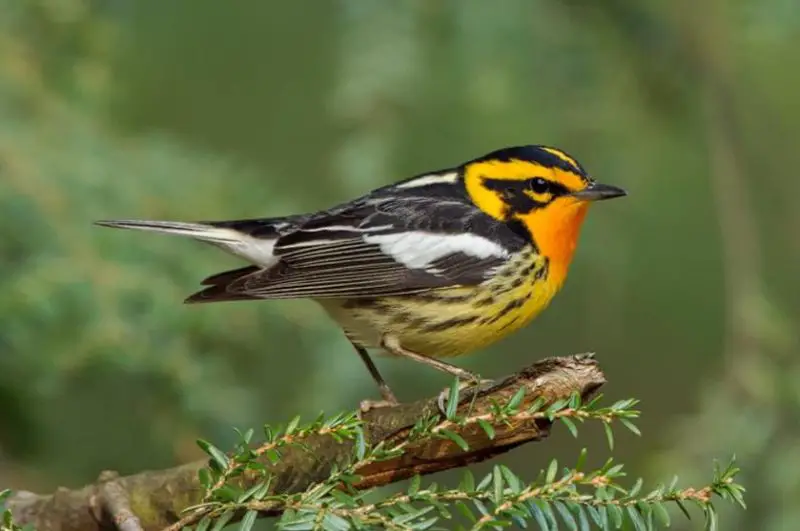
The Blackburnian Warbler is one of the most brilliantly colored orange birds to pass through Michigan, particularly noticeable during migration. Males in breeding plumage are stunning, with a fiery orange throat and face bordered by bold black markings, a black crown, and streaked black-and-white wings. Females and immatures are more muted, showing yellow-orange throats and less distinct facial patterns, but they remain identifiable by their warm hues. Their small size and high-energy movements make them both challenging and rewarding to spot.
Blackburnian Warblers breed in northern coniferous and mixed forests, including parts of northern Michigan’s woodlands. However, they are most often observed during spring and fall migration when they pass through the state en route to and from their breeding and wintering grounds. In spring, their high-pitched song, often described as a thin series of notes that rise to a squeaky climax, can alert birders to their presence. They tend to forage high in the canopy, so patience and careful scanning are required to see them well.
Their diet consists mainly of insects and spiders, which they glean from leaves and twigs or catch in mid-air. They are especially adept at feeding among the upper branches of tall trees, often associating with mixed flocks of warblers and other songbirds. This feeding behavior allows them to exploit food sources that many ground- or shrub-level birds cannot access. By consuming large numbers of forest insects, Blackburnian Warblers play an important role in maintaining ecological balance in their habitats.
Nesting occurs primarily in dense coniferous forests, with females building small cup-shaped nests high in spruce or fir trees. In Michigan, breeding is more common in the Upper Peninsula and northern Lower Peninsula, though migration brings them across the entire state. Their glowing orange throat, combined with their preference for treetop foraging, has earned them a reputation as one of the most dazzling warblers to observe in North America.
Red-breasted Nuthatch (Sitta canadensis)

The Red-breasted Nuthatch is a small, energetic bird with a striking mix of colors that includes rusty-orange underparts. Its compact body is accented by a bluish-gray back, a bold black cap, and a white face marked with a prominent black eye stripe. The reddish-orange breast and belly are the key features that make it stand out as one of Michigan’s orange-toned birds. Despite its small size, its sharp “yank-yank” calls and acrobatic movements make it highly noticeable.
In Michigan, Red-breasted Nuthatches are found primarily in coniferous and mixed forests, especially in the northern regions and the Upper Peninsula. They are year-round residents, but their numbers can fluctuate depending on cone crop cycles, often leading to “irruption years” when many move south into central and southern Michigan. They are also frequent visitors to backyard feeders, where they enjoy sunflower seeds, peanuts, and suet.
Their behavior is distinctive and easily recognizable: they forage by creeping along tree trunks and branches, often moving headfirst down the bark. This upside-down feeding style allows them to probe for insects, larvae, and spiders hidden in crevices that other birds may miss. In winter, their diet shifts heavily toward conifer seeds, especially spruce and pine cones, which they pry open skillfully with their sharp bills.
During breeding, they excavate nest cavities in decayed trees or reuse old woodpecker holes. A unique behavior of this species is smearing sticky conifer resin around the entrance of the nest hole, possibly as a deterrent against predators. The Red-breasted Nuthatch may be small, but its rusty-orange underparts, bold markings, and quirky feeding style ensure it stands out in Michigan’s birdlife.
Scarlet Tanager (Piranga olivacea)
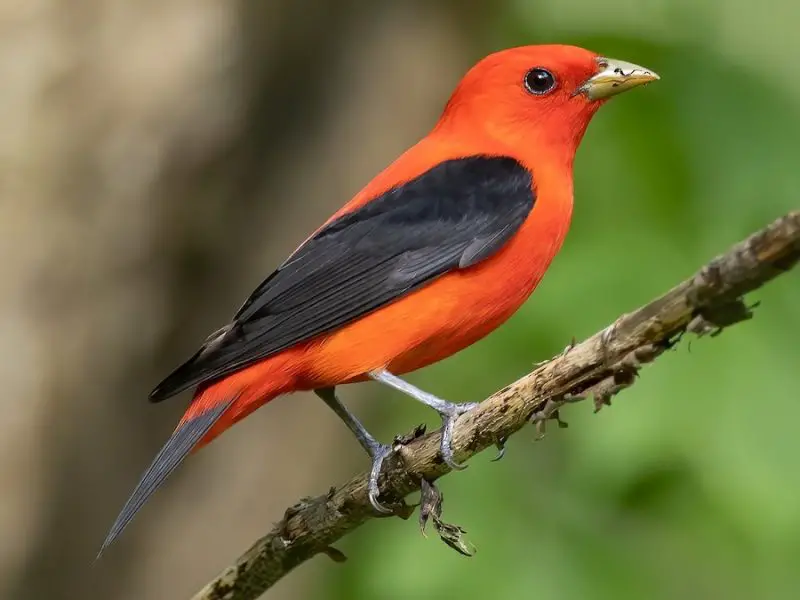
The Scarlet Tanager is one of the most dramatic birds to appear in Michigan during summer, though its coloration can sometimes appear more orange-red, depending on the lighting. Breeding males are unmistakable, with a brilliant scarlet body contrasted by jet-black wings and tail. Females and non-breeding males are much duller, with yellow-green plumage, but even they may show hints of orange tones. Their medium size, thick bill, and vivid colors make them a highlight of summer birdwatching.
Scarlet Tanagers are found in mature deciduous and mixed forests across Michigan, especially in the southern and central parts of the state. They prefer the forest interior rather than edges, making them harder to spot despite their bright coloring. Their burry, robin-like song often gives away their location high in the treetops, along with their sharp “chip-burr” call note. Migration brings them from South America in May, and they remain until late summer before heading south again.
Feeding mostly on insects, they actively glean beetles, caterpillars, wasps, and other arthropods from leaves and branches. They are also skilled at snatching flying insects mid-air. As summer progresses, they add more fruit to their diet, feeding on berries and wild cherries that are abundant in Michigan forests. This varied diet supports them through the demanding breeding season and their long migration journey.
Breeding behavior is also notable, as males defend territories vigorously with persistent singing and displays. Females build well-hidden nests in high branches, laying three to four eggs. Despite their striking plumage, Scarlet Tanagers can be difficult to spot because they stay high in dense foliage. For birders lucky enough to see them, the fiery orange-red glow of a male Scarlet Tanager against green leaves is an unforgettable sight.
House Finch (Haemorhous mexicanus)
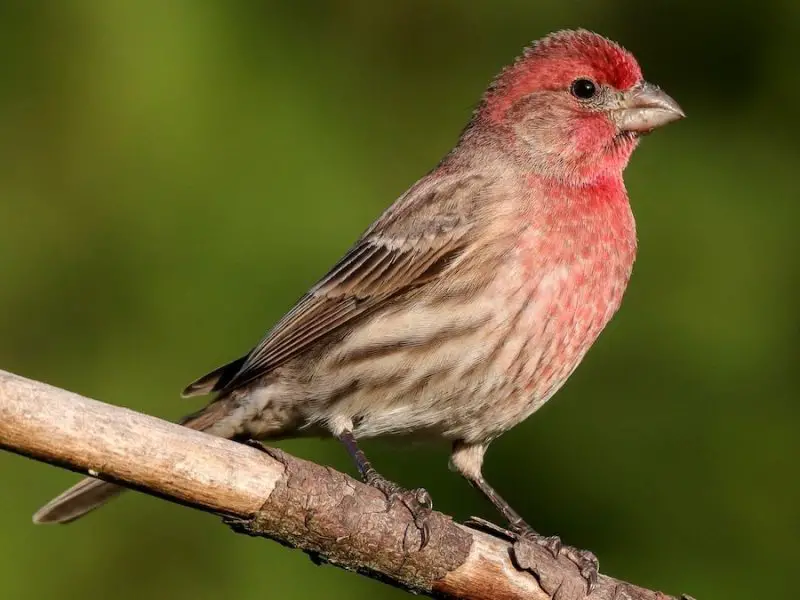
The House Finch is a common backyard bird in Michigan, and while males are typically red, many show orange or even yellow variations in their plumage. This color difference is influenced by diet, particularly the pigments in the seeds and fruits they consume. Males generally display orange-red coloring on the head, chest, and rump, while females are streaky brown with no bright coloration. This variability makes them one of the most frequently seen orange-tinged birds in the state.
House Finches thrive in urban, suburban, and rural areas, adapting well to human presence. They are year-round residents in Michigan and can be found at feeders throughout all seasons. Their cheerful, warbling song is a common sound in neighborhoods, parks, and gardens. They prefer areas with shrubs and trees for nesting but are just as comfortable making use of man-made structures like hanging planters and building ledges.
Their diet is primarily plant-based, consisting of seeds, grains, buds, and fruits. They are enthusiastic visitors to feeders stocked with sunflower seeds, millet, or thistle. Unlike many birds, they rarely eat insects, even during breeding season. The pigments in their food directly influence the coloration of males, which is why some individuals show orange rather than bright red tones. This variation adds an extra layer of interest when identifying them.
During breeding season, females build nests in sheltered locations, often in close proximity to people. They raise multiple broods each year, which contributes to their widespread abundance. Their adaptability, tolerance of human environments, and the possibility of encountering orange-hued males make House Finches one of Michigan’s most reliable orange-plumaged species.
Barn Swallow (Hirundo rustica)

The Barn Swallow is another orange-bellied bird that can be seen across Michigan during the warmer months. This species is instantly recognizable by its long, deeply forked tail and graceful, acrobatic flight. Adults have glossy blue upperparts and a warm rusty-orange underside, with a rufous-orange throat and forehead. The contrast of their sleek wings and bright underparts makes them one of the most elegant of Michigan’s summer birds.
These swallows arrive in Michigan during spring migration, usually in April, and remain until late summer or early fall. They are strongly associated with open landscapes, farmlands, fields, and bodies of water where flying insects are abundant. True to their name, they often nest in barns, sheds, and other man-made structures, attaching their mud nests under eaves and rafters. Their close association with humans has made them one of the most familiar swallows in the state.
Their diet consists almost entirely of flying insects, which they catch in mid-air with remarkable agility. Mosquitoes, flies, beetles, and moths make up the bulk of their food. Watching a flock of Barn Swallows darting and swooping above fields or ponds is a classic summer sight in Michigan. Their aerial feeding habits also make them beneficial to farmers and communities by reducing insect populations.
During the breeding season, Barn Swallows form loose colonies, with pairs building mud nests reinforced with grass and lined with feathers. Both parents share in feeding the young, which grow quickly and fledge in just a few weeks. By late summer, large groups gather before migrating south to Central and South America. The Barn Swallow’s combination of orange underparts, forked tails, and graceful flight makes them a cherished part of Michigan’s birdlife.
Best Time and Places to See Orange Birds in Michigan
Michigan offers birdwatchers excellent opportunities to observe orange-plumaged birds throughout the year, but spring and summer are the most rewarding seasons. From April through early June, migratory species like Baltimore Orioles, Orchard Orioles, Blackburnian Warblers, and Scarlet Tanagers return from their wintering grounds, filling forests, orchards, and backyards with color and song. Early mornings during this period are particularly productive, as birds are most active and vocal.
The best places to see these birds vary depending on the species. Forest interiors and mature woodlands are prime locations for spotting Scarlet Tanagers and Blackburnian Warblers, while shrubby edges and overgrown fields are ideal for Eastern Towhees. Baltimore and Orchard Orioles are more likely to appear in suburban yards, parks, and orchards, where fruit trees and feeders attract them. American Robins, House Finches, and Barn Swallows are widespread and easy to see in both rural and urban settings.
Birding hotspots across Michigan include state parks, wildlife refuges, and lakefront areas. The Upper Peninsula and northern Lower Peninsula forests provide excellent habitats for Blackburnian Warblers and Red-breasted Nuthatches, while southern Michigan farmlands and orchards host orioles and towhees. Even backyard feeders in residential areas can be excellent vantage points for observing orange-toned birds like orioles and finches, especially in May when migration peaks.
FAQs about Orange Birds in Michigan
What is the most common orange bird in Michigan?
The American Robin is the most common orange bird in Michigan. Found statewide, it is a year-round resident and is easily recognized by its orange breast and cheerful song.
When do Baltimore Orioles arrive in Michigan?
Baltimore Orioles typically arrive in Michigan in late April or early May. They are migratory birds that spend winters in Central and South America and return to breed during the spring and summer months.
Are there orange birds in Michigan during winter?
Yes, a few orange-toned birds can be seen in winter, such as the American Robin (in southern regions) and the Red-breasted Nuthatch. Most bright orange species, like orioles and tanagers, migrate south for the winter.
Where is the best place to see Blackburnian Warblers in Michigan?
The best places to see Blackburnian Warblers are in northern Michigan’s mature coniferous and mixed forests, particularly during breeding season. During migration in spring and fall, they can also be seen passing through wooded areas across the entire state.
Do House Finches in Michigan always look red?
Not always. While many male House Finches are red, some individuals appear orange or even yellow. This color variation depends on the pigments in their diet, making them an interesting and variable species to observe.



